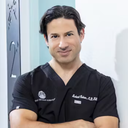I also prefer saline over silicone. It is surgeon preference. This is still quite controversial. The single most issue is when a saline implant ruptures, you know immediately, and there is a compelling change in appearance. While it is not dangerous nor do you need immediately surgery, this can be disquieting. It prompts the patient to seek replacement sooner and with some understandable anxiety and financial commitment. Yet in properly screened and selected patients, using an under muscle approach or dual plane approach, the results are comparable for saline and silicone, except in the very thin person who goes very large. In that case, silicone can be considered an advantage. We have patients returning just since 2010 who have saline implants in place 12 to 25 years having but one operation only. No capsulectomies, extensive revisions for silicone rupture and gel spread, and no multiple mammograms or MRIs for silicone gel issues. I do think I performed vastly fewer procedures for implant hardness and scarring in saline augmented patients. Again, it is usually the very slender patient with a full C or D cup and beyond, that are inclined to scarify more easily. Each implant fill has its issues, but I can say I am more inclined to stay with saline. The unhappy patients have a rupture early than anticipated, or have more than one in a short period. I do think the saline implants having a broad fill range allow the surgeon some latitude for minor adjustments especially when a lift is performed at the same time. When we use saline in place of silicone in those unfortunate patients who have had numerous procedures for scar tissue, they again, seem to do better. Also, I prefer the areolar scar, as the underneath scar required for any silicone gel augmentations can be vexing. I have been faced with more problems from from the inframammary scar when performing revisions, especially from outside referrals, since that scar can indent and widen more than an areolar scar. Each implant, and each method of approach has its tradeofffs. Finally, I prefer smooth shell implants as I do not think texturing adds any advantages except to prevent shaped implants from rotating. I think the round saline implants at different projections can solve most anatomic concerns when a formal lift is not needed. Textured implants can add a new set of issues, and when a silicone gel augmented patient gets a rupture, it may go unnoticed for years. Even if diagnosed, I have found that a number of patients wish nothing to be done, since they are still happy with the shape and softness. I cannot get through to these patients that ruptured silicone gel implants need to be removed and replaced. That is why I stay with saline. I do not have to worry about silicone floating around where it should not be. I do believe for the sudden saline rupture issue in the average patient, that is a daunting dilemma for the patient and surgeon. Expense for secondary silicone gel implant surgery may also far surpass that for secondary saline implant surgery. These are personal perspectives and subjective to debate and discussion by all surgeons who use their judgment and clinical experience to determine what breast augmentation protocol they use.






